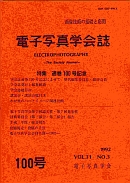Volume 22, Issue 3
Displaying 1-6 of 6 articles from this issue
- |<
- <
- 1
- >
- >|
-
1984Volume 22Issue 3 Pages 191-197
Published: March 30, 1984
Released on J-STAGE: April 12, 2014
Download PDF (693K) -
1984Volume 22Issue 3 Pages 198-208
Published: March 30, 1984
Released on J-STAGE: April 12, 2014
Download PDF (1198K) -
1984Volume 22Issue 3 Pages 209-215
Published: March 30, 1984
Released on J-STAGE: April 12, 2014
Download PDF (971K)
-
1984Volume 22Issue 3 Pages 217-220
Published: March 30, 1984
Released on J-STAGE: April 12, 2014
Download PDF (501K) -
1984Volume 22Issue 3 Pages 221-227
Published: March 30, 1984
Released on J-STAGE: April 12, 2014
Download PDF (3959K) -
1984Volume 22Issue 3 Pages 228-23242
Published: March 30, 1984
Released on J-STAGE: April 12, 2014
Download PDF (509K)
- |<
- <
- 1
- >
- >|
